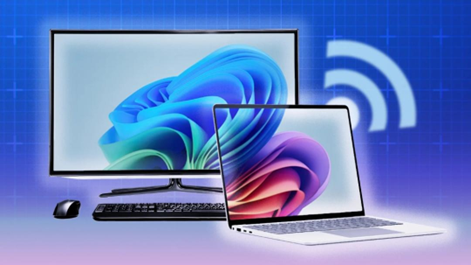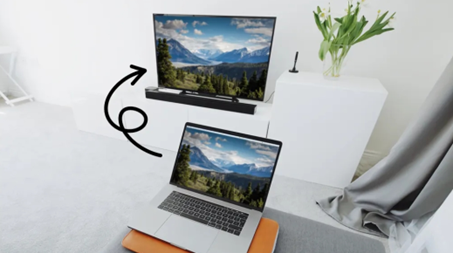Connecting a laptop to a TV screen without any cables is easier than ever. With modern wireless display technology, you can mirror your screen, stream content, or extend your display for a larger viewing experience. Whether you're using a smart TV, streaming device, or web browser, there are many ways to eliminate cords and clutter. This guide on How to Connect a Laptop to a TV Screen walks you through each method so you can enjoy seamless viewing—no HDMI cables needed.

Use Built-In Wireless Display Features
Many smart TVs now support native wireless display features. You can mirror your laptop screen by using compatibility tools already built into your devices.
Enable Miracast, AirPlay, or WiDi on Your TV
Start by activating the wireless display feature on your TV. Windows users should look for Miracast support, while Mac users will rely on AirPlay. Some older systems may use Intel WiDi. Navigate to your TV’s settings and enable the screen mirroring or display-sharing mode. This prepares your TV to receive a wireless connection from your laptop. Most newer smart TVs come with these capabilities pre-installed, so there's no need for extra software or complicated setup steps.
Connect Laptop and TV to the Same Wi-Fi Network
Ensure both your TV and laptop access the same home network. Wireless display tools like Miracast or AirPlay won’t function properly if your devices are on separate Wi-Fi bands or routers. Use your router’s settings to check connected devices. Avoid using guest networks or mobile hotspots. Matching networks help the devices discover each other quickly and maintain a reliable connection. If possible, assign static IPs to improve signal handshakes and prevent occasional signal drop-offs during casting.
Project or Mirror Screen from Display Settings
On your laptop, go to display settings. Windows users can press Windows + K or search for “Project to this PC.” Select your TV from the available list. Mac users can open Control Center and tap “Screen Mirroring,” then choose their smart TV. Once connected, select whether you want to mirror or extend your display. The screen should appear on your TV in seconds. If needed, adjust resolution or scaling to fit the TV screen properly.

Connect Through a Streaming Device
Using a streaming stick like Chromecast or Fire TV gives you more flexibility. These tools support a variety of wireless display features.
Plug In and Set Up the Streaming Stick on the TV
Insert the streaming stick into an HDMI port on your TV and connect it to a power source. Follow the on-screen prompts to complete the initial setup. You’ll need to pair the device with your Wi-Fi network using the companion app or remote. Make sure both the streaming stick and your laptop share the same network. Once the setup is complete, your TV will show up as a cast-ready option from compatible apps and browsers on your laptop.
Use a Laptop Browser or App to Cast Content
Open a browser like Chrome or launch a supported app such as YouTube or Netflix. Look for the cast icon—typically a rectangle with waves in the corner—and click it. Your streaming stick should appear as an available device. Select it, and your content will start playing on the TV. Some platforms also support casting entire tabs or apps. Casting is ideal for watching videos, displaying photos, or presenting slideshows directly from your laptop.
Adjust Display Format and Playback Quality
Once content is playing, you can adjust playback settings for better visuals. Use the streaming stick’s app or remote to modify resolution, subtitles, and volume. On your laptop, right-click the tab and choose to cast in full-screen or a specific aspect ratio. Lower the resolution if your connection lags or stutters. Most devices automatically optimize based on bandwidth, but manual tweaks can improve performance. This ensures a consistent experience whether you're streaming movies, music, or screen content.
Troubleshoot Wireless Connection Problems
If your devices fail to connect or the display lags, try these simple fixes to get your screen sharing back on track.
Restart Devices and Reconnect to Wi-Fi
When a wireless connection fails, restart both your laptop and TV or streaming stick. Power cycling clears background tasks or bugs that interfere with detection. After rebooting, recheck that each device connects properly to the router. Don’t just disconnect—choose “Forget Network” and reconnect from scratch. This helps refresh network credentials and removes cached conflicts. Often, a clean restart sequence is all it takes to restore wireless display functionality and get both screens synced again.
Update Display Drivers and System Software
Outdated display drivers can interfere with wireless casting. On your laptop, visit the Device Manager and check for display adapter updates. Also, ensure your operating system is current. Smart TVs and streaming devices should also have the latest firmware. Updates often include performance improvements and bug fixes for casting features. Installing the latest versions helps devices communicate more smoothly and ensures better compatibility with screen-sharing tools, especially after system upgrades or patches.
Reduce Network Load or Use 5GHz Wi-Fi Band
For optimal performance, reduce background internet activity like large downloads, streaming, or online gaming. These tasks consume bandwidth and cause video freezing or desync during casting. If available, switch to a 5GHz Wi-Fi band—it offers higher speed and less congestion than 2.4GHz. This is especially helpful in busy households with multiple devices. Also, keep your router in a central, elevated spot to ensure better signal coverage between your laptop and TV.
Conclusion
Wirelessly connecting a laptop to a TV is simple with the right tools. Whether you’re using built-in features like Miracast and AirPlay, or external solutions like streaming sticks or browser casting, each method offers a smooth, cable-free experience. Ensuring both devices are on the same network and updated helps avoid issues. You can easily stream videos, mirror presentations, or enjoy full desktop control from the comfort of your couch. Try out different options to see what works best for your setup, and enjoy a clutter-free home entertainment or work environment.
FAQ
1. Do I need smart TV features to connect wirelessly?
Not necessarily. While smart TVs offer built-in wireless display features, you can still connect wirelessly using devices like Chromecast, Roku, or Fire Stick. These gadgets add casting and screen-mirroring support even to older TVs with an HDMI port.
2. Why is there lag when I mirror my screen?
Screen lag usually comes from a weak Wi-Fi signal, high network traffic, or outdated drivers. Try switching to a 5GHz network, closing background apps, or updating your laptop and TV firmware to reduce latency and improve streaming quality.
3. Can I wirelessly connect without installing extra apps?
Yes. If your TV supports Miracast, AirPlay, or has Chromecast built-in, you don’t need third-party apps. Just use native tools on Windows, macOS, or your browser to connect directly. Streaming sticks also require no additional apps once set up.
